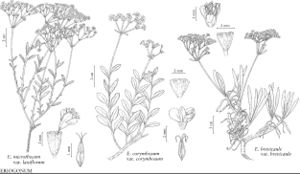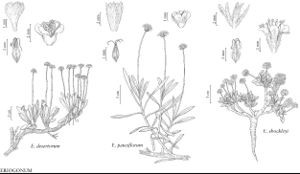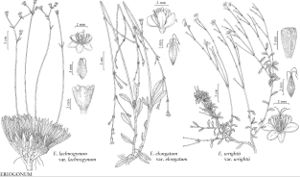Eriogonum
Fl. Bor.-Amer. 1: 246, plate 24. 1803.
Shrubs, subshrubs, or herbs, sometimes nearly arborescent, perennial, biennial, or annual, polycarpic or, rarely, monocarpic (subg. Pterogonum), synoecious (sometimes polygamodioecious in subg. Micrantha and Oligogonum, rarely dioecious in subg. Oligogonum); taproot slender to stout, solid, or rarely chambered (subg. Pterogonum). Stems prostrate or decumbent to erect, infrequently absent, glabrous or pubescent, sometimes glandular; caudex stems absent or woody, tightly compact to spreading and at or just below surface, or spreading to erect and above surface; aerial flowering-stems arising at nodes of caudex branches, at distal nodes of aerial branches, or directly from the root, prostrate or decumbent to erect, slender to stout, solid or slightly to distinctly hollow and fistulose, rarely disarticulating into ringlike segments (subg. Clastomyelon). Leaves usually persistent through anthesis, occasionally persistent through growing season or longer, sometimes marcescent or quickly deciduous, basal and sometimes sheathing up stems, cauline, or basal and cauline, alternate, opposite, or whorled, 1 per node or fasciculate; petiole usually present, sometimes obscure; blade linear to orbiculate, entire apically. Inflorescences terminal or terminal and axillary, cymose and dichotomously or trichotomously branched, or racemose, simple or compound-umbellate, subcapitate, or capitate, occasionally distally uniparous due to suppression of secondary branches; branches mostly dichotomous except for initial trichotomous node, not brittle or disarticulating into segments, round and smooth, rarely grooved, angled or ridged, variously lanate, tomentose, floccose, sericeous, hispid, pilose-pubescent, or puberulent, occasionally glandular, rarely scabrellous; bracts 2–13 or more at proximal nodes, usually 3 distally, connate proximally, leaflike, semileaflike, or scalelike, not awn-tipped, glabrous or variously pubescent or glandular. Peduncles absent or erect to deflexed. Involucres 1–8 or more per cluster, smooth or ribbed, tubular, cylindric or narrowly turbinate to broadly campanulate or hemispheric; teeth 5–10, sometimes lobelike, not awned. Flowers bisexual or, infrequently, unisexual, (2–) 6–100 per involucre at any single time during full anthesis, sometimes with stipelike base; perianth usually white to red or variously yellow, broadly campanulate when open, cylindric to urceolate when closed, glabrous or pubescent or glandular abaxially; tepals 6, connate proximally to 1/2 their length, monomorphic or dimorphic, usually entire apically, rarely emarginate; stamens 9; filaments adnate basally, glabrous or pubescent; anthers usually red to cream or yellow, oblong to ellipsoid or oval. Achenes included to exserted, various shades of brown, black, or occasionally yellow, rarely winged or ridged (subg. Pterogonum), lenticular or 3-gonous, glabrous or pubescent. Seeds: embryo curved or straight. x = 10.
Contents
Distribution
North America (including n Mexico)
Discussion
Species ca. 250 (224 in the flora).
Eriogonum is the basal group of subfam. Eriogonoideae. Like all of its related genera, Eriogonum is a highly derived tetraploid taxon that has undergone rapid evolution in arid regions of western North America. The circumscription of the genera in the subfamily is now being studied molecularly and cladistically. The approach taken here is to divide the group into numerous genera, acknowledging that the resulting Eriogonum remains paraphyletic and that all genera of Eriogoneae are imbedded within Eriogonum as presently circumscribed. Resolution may well come with the reduction of the subfamily to two genera, Eriogonum and Pterostegia (including Harfordia Greene, a genus of Baja California, Mexico), or, at the other extreme, reducing Eriogonum to just two species. What the future will hold is difficult to ascertain at this time.
As presently circumscribed, Eriogonum is one of the larger genera in the flora area, being exceeded in numbers of species only by Carex (ca. 480), Astragalus (ca. 350), and Penstemon (ca. 250). As a native North American genus, Eriogonum (ca. 250) is second only to Penstemon. Ecologically, species of Eriogonum occur from the seashore to the highest mountains in the United States. They are among the last plants seen atop the Sierra Nevada and on the “outskirts” of Badwater in Death Valley. About one-third of the species are uncommon to rare in their distribution. The United States Department of the Interior currently lists some as endangered or threatened species. Some species tend to be weedy, and some of the annual species are aggressively so.
Species of Eriogonum have long been regarded as among the most difficult in North America to distinguish. Regional treatments should be consulted before attempting to use this review, especially for plants found outside California or the Intermountain West. Geographic distribution is a useful character, and such information is given fully in keys and discussion here to aid with identification. In addition to regional keys noted below, keys exist for Texas (J. L. Reveal 1970b), the Pacific Northwest (J. L. Reveal 1973), and the Great Plains (R. Kaul 1986). In each instance the nomenclature should be compared with that presented here. To aid in the identification of species belonging to the largest subgenus, Eucycla, regional keys are given here, thereby avoiding a long and complex key to the more than 100 species.
In collecting specimens of Eriogonum, try to obtain leaves (especially for annuals), fruits (especially those belonging to subg. Pterogonum), and ample flowers (rarely difficult to accomplish). Field observations on flower color, pubescence, and overall size and habit are useful. Some species (especially those of subg. Oligogonum) are dioecious, with the mature staminate and pistillate plants occasionally markedly different in aspect. It is not uncommon for several annual species to grow intermixed in disturbed places, so care must be taken to prevent mixed collections. Finally, as in all cases, collectors should try to sample the range of variation rather than concentrate on extremes.
Eriogonum has a long history of aboriginal use. Today, several members of the genus are in cultivation, especially in the rock or alpine garden (G. Nicholls 2002).
Members of Eriogonum are hosts for a number of butterfly species, including such endangered ones as the El Segundo dotted-blue (Euphilotes battoides allyni), Smith’s dotted blue (Euphilotes enoptes smithi), and Lange’s metalmark (Apodemia mormo Iangei). Species of the genus Euphilotes spend their entire life on particular species complexes. Other butterfly species found in association with Eriogonum and relatives (see P. A. Opler and A. B. Wright 1999) include the western green hairstreak (Callophrys affinis), desert green or Comstock’s hairstreak (C. comstocki), bramble hairstreak (C. dumetorum), Lembert’s hairstreak (C. lemberti), Sheridan’s green hairstreak (C. sheridani), green hairstreak (C. viridis), varied blue (Chalceria heteronea), Rocky Mountain dotted-blue (Euphilotes ancilla), Bauer’s dotted-blue (E. baueri), Bernardino dotted-blue (E. bernardino), Ellis’s dotted-blue (E. ellisi), Pacific dotted-blue (E. enoptes), intermediate dotted-blue (E. intermedia), Mojave dotted-blue (E. mojave), pallid dotted-blue (E. pallescens), Rita dotted-blue (E. rita), Spalding’s dotted-blue (E. spaldingi), Gorgon copper (Gaeides gorgon), gayas or Edward’s blue (Hemiargus ceranus gyas), blue copper (Lycaena heteronea), small blue (Philotiella speciosa), Boisduval’s blue (Plebeius icarioides), acmon blue (P. acmon), lupine blue (P. lupini), veined blue (P. neurona), California hairstreak (Satyrium californica), nut-brown hairstreak (S. saepium), Avalon scrub-hairstreak (Strymon avalona), and gray hairstreak (S. melinus). Flowering plants of Eriogonum are infrequently visited by the sooty hairstreak (Satyrium fulginosum), the flowers being a source of nectar for adults. According to Opler, several additional species and subspecies of these butterflies remain to be described.
Selected References
Lower Taxa
Key
Key to the Subgenera of Eriogonum
| 1 | Flowers attenuate at base, sometimes only weakly so, stipelike base not at all winged; inflorescence bracts 2-10 or sometimes more | > 2 |
| 1 | Flowers not attenuate at base, stipelike base absent or, if present, then slightly winged; inflorescence bracts usually 3 | > 3 |
| 2 | Tall, erect perennials; perianths white-tomentose. | Eriogonum subg. Eriogonum |
| 2 | Low, spreading, cespitose to shrubby, perianths glabrous or, if pubescent, not white-tomentose | Eriogonum subg. Oligogonum |
| 3 | Plants annual or, if perennial, then involucres usually distinctly pedunculate; leaves usually basal, usually tomentose at least abaxially, or if pilose or strigose then plants of desert regions | > 4 |
| 3 | Plants perennial herbs, subshrubs, or shrubs or, if annual or biennial, then stems usually 1, leafy throughout, and plants polygamodioecious; involucres (except 1 at fork of node in some) typically sessile, or if pedunculate throughout then leaves neither roundish and plants from central and southern Texas, nor perianths yellow-hispid and leaves hirsute | > 5 |
| 4 | Involucres smooth, not ribbed or angled, usually on a peduncle or, if sessile, then involucres not appressed to inflorescence branches | Eriogonum subg. Ganysma |
| 4 | Involucres angled to strongly ribbed, strongly appressed to inflorescence branches and sessile or terminal on bracteated branchlets, rarely pedunculate | Eriogonum subg. Oregonium |
| 5 | Plants herbaceous perennials, subshrubs, or shrubs, sometimes nearly arborescent, without jointed stems, without winged or distinctly ridged achenes | Eriogonum subg. Eucycla |
| 5 | Plants annuals or biennials or, if perennials, then stems jointed basally, or achenes winged or distinctly ridged | > 6 |
| 6 | Plants biennial or annual | Eriogonum subg. Micrantha |
| 6 | Plants perennial | > 7 |
| 7 | Involucres sessile in axils of inflorescence bracts, becoming ruptured at maturity by numerous bractlets and pubescent flowers; stems jointed basally | Eriogonum subg. Clastomyelon |
| 7 | Involucres pedunculate, not ruptured by bractlets and (usually glabrous)flowers; stems not jointed basally | Eriogonum subg. Pterogonum |
"/2" is not declared as a valid unit of measurement for this property.


